Core i7: 4-Way CrossFire, 3-way SLI, Paradise?
X58 And SLI Get Busy
The use of Intel’s X58 chipset does not automatically imply SLI compatibility. In order for a motherboard to support SLI, it must first be certified by Nvidia—a process that reportedly involves stability, power, compatibility, and layout testing. If a prospective platform passes those four metrics, it is technically eligible for an SLI license.
We’re not sure what Nvidia is charging for a license, but that price will most definitely be passed on through the board vendors. Then again, with prices on X58-based boards expected to hover close to the $300 mark, we have to figure that the relative addition with SLI licensing will be small versus motherboards without SLI support.
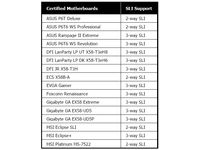
According to Nvidia, the validation process to make sure an X58 platform works properly with SLI is fairly extensive. Motherboards are tested with two-way, 3-way, and quad-SLI setups and a number of different third-party devices. The boards are then run through the top 15 titles for sales, the top 15 used for benchmarking, titles with PhysX support, and a barrage of video performance measurements. The mechanical specs of each candidate are tested. They’re then subjected to a stress test and PCI Express-specification verification.
This information is likely very similar to what AMD does in certifying boards for CrossFireX compatibility as well. It’s only newsworthy now because Nvidia only recently opened the doors to licensing, while we’ve had CrossFire compatibility on Intel chipsets for some time.
Naturally, if SLI support is one of your qualifications for buying a new X58-based board, you’ll want to keep a sharp eye out to make sure the feature is included. It’s worth noting that Intel’s DX58SO motherboard does not support SLI. We asked Intel to comment on the situation and heard back that the two companies had not found mutually-acceptable business terms for the certification.
Getting Your Slots Straight
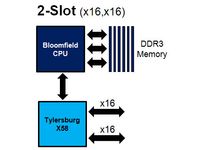
There are a grand total of six different configurations you may or may not see motherboard vendors use as they add SLI support to their products. Four are considered native, and rely on X58’s twin x16 links of PCI Express 2.0 connectivity. The other two involve Nvidia’s nForce 200 companion chip.
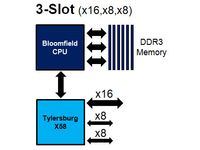
The most basic implementation of X58 involves two x16 slots, each running at x16 signaling rates. Naturally, an SLI-certified board with this setup maxes out with a pair of GeForce GTX 280s. That’s certainly no slouch of a configuration, but most of the motherboards we’ve seen strive for more. As an aside, a board armed with what Nvidia calls a native two-slot setup will also support a pair of Radeon HD 4870 X2s. So this is hardly a constraining arrangement.
Get Tom's Hardware's best news and in-depth reviews, straight to your inbox.
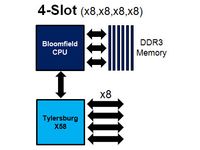
A native three-slot configuration is fancier, but it’s still possible using nothing but Intel’s X58 core logic. One of the chipset’s x16 links remains x16 electrically, but the second one is split into a pair of x8 links connected to x16 slots. The catch, according to Nvidia, is that those x8 connections don’t give you the full bandwidth of a x16 slot. However, we’re talking about PCI Express 2.0 here—we haven’t seen any evidence yet to suggest today’s cards need more throughput than that connection can provide (though we do have a PCI Express scaling story in the works, which should shed additional light on this matter). Using the three-slot setup, certified boards are able to run 3-way SLI—a claim we confirm and explore in this story.
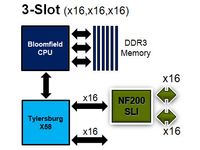
We haven’t seen any motherboards with this slot arrangement yet, but Nvidia mentions a native four-slot mode enabled by dividing both of X58’s x16 links in half. This would be the way to go if you wanted to run 3-way SLI with a fourth GPU dedicated to PhysX acceleration. We had enough trouble running 3-way SLI, though. Heat is not this configuration’s friend, and the standard fan control simply doesn’t compensate for the fact that a trio of boards is cranking out fiery temperatures. Throwing a fourth card into the mix sounds like a recipe for frustration.
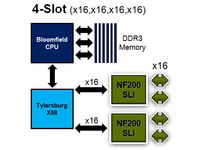
The fifth possibility involves X58 with Nvidia’s nForce 200 chip. Intel’s Tylersburg (X58’s internal designation) maintains one of its x16 links. The other is hooked up to nForce 200, which in turn creates two more x16 links of PCI Express 2.0. Nvidia says that the use of broadcast and peer-to-peer writes gives this configuration an advantage, even though it ultimately has two cards hooked to the same x16 link as a native arrangement. Purportedly, because the boards attached to the nForce 200 can communicate directly, potential for better performance exists. In our talks with motherboard vendors, though, none seemed particularly enthusiastic about integrating nForce 200.
Finally, we may see workstation or server-class motherboards incorporating two nForce 200 chips—one for each of X58’s links and designed to facilitate maximum throughput between all of the attached cards in a four-way setup. This would be the way to go for a machine loaded down with Tesla boards, Nvidia tells us.
Current page: X58 And SLI Get Busy
Prev Page Tempered Expectations Next Page Caveats, Realism, And Driver Hell-
DFGum Yep, i hafta say being able to switch brands of graphics cards on a whim and selling off the old is great. Knowing im going to be getting the preformance these cards are capable of (better price to preformance ratio) is nice also.Reply -
cangelini randomizerSLI scales so nicely on X58.Reply
Hey you even got a "First" in there Randomizer! -
randomizer cangeliniHey you even got a "First" in there Randomizer!And modest old me didn't even mention it. :lol:Reply -
enewmen Still waiting for the 4870 X2s to be used in these bechmarks. I thought THG got a couple for the $4500 exteme system. But still happy to see articles like this so early!Reply -
cangelini enewmenStill waiting for the 4870 X2s to be used in these bechmarks. I thought THG got a couple for the $4500 exteme system. But still happy to see articles like this so early!Reply
Go check out the benchmark pages man! Every one with 1, 2, 4 4870s. The 2x and 4x configs are achieved with X2s, too.
Oh, and latest drivers all around, too. Crazy, I know! =) -
enewmen cangeliniI found it, just read the article too quickly. - My bad.Reply
"A single Radeon HD 4870 X2—representing our 2 x Radeon HD 4870 scores—is similarly capable of scaling fan speed on its own. "
Hope to see driver updates like you said. -
spyde Hi there, my question regarding these benchmarks with the HD card is, "was a 2G card use or a 1G". I am about to buy a new system and was looking to buy 2 x HD4870X2 2G cards, but with these results its looking a bit ify. I hope you can answer my question.Reply
Cheers. -
Proximon That's a nice article. I especially like the way the graphs are done. everything is scaled right, and you get an accurate representation.Reply
